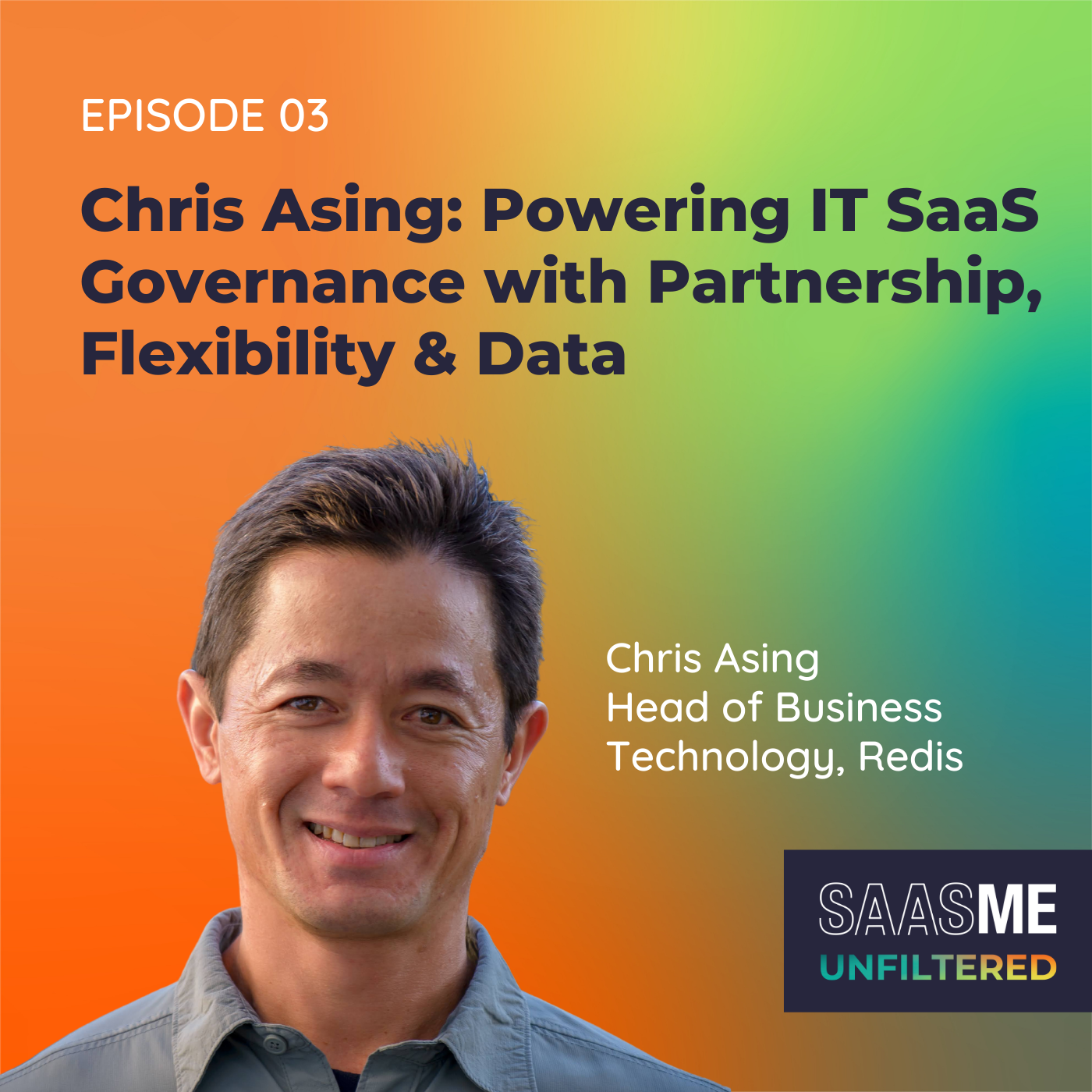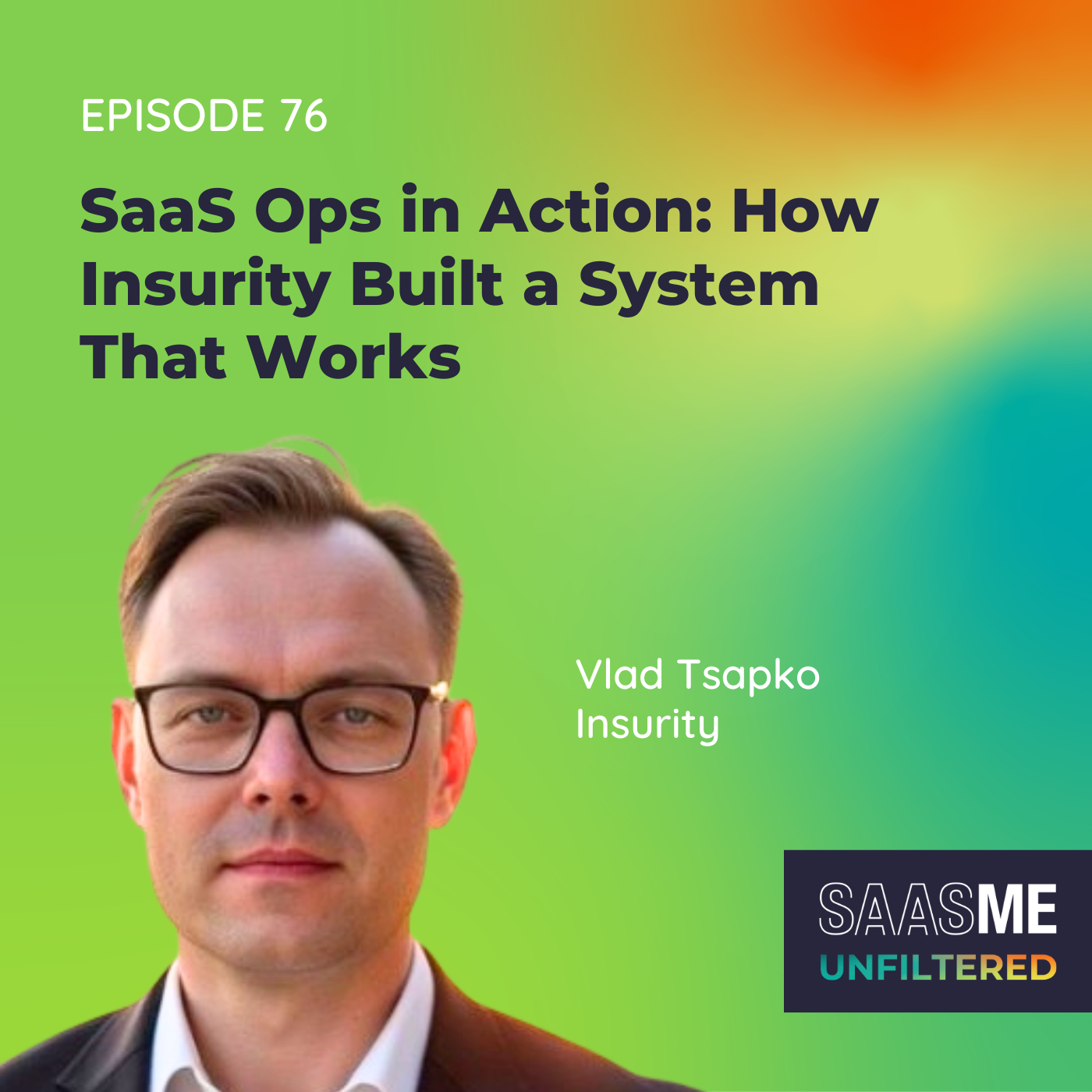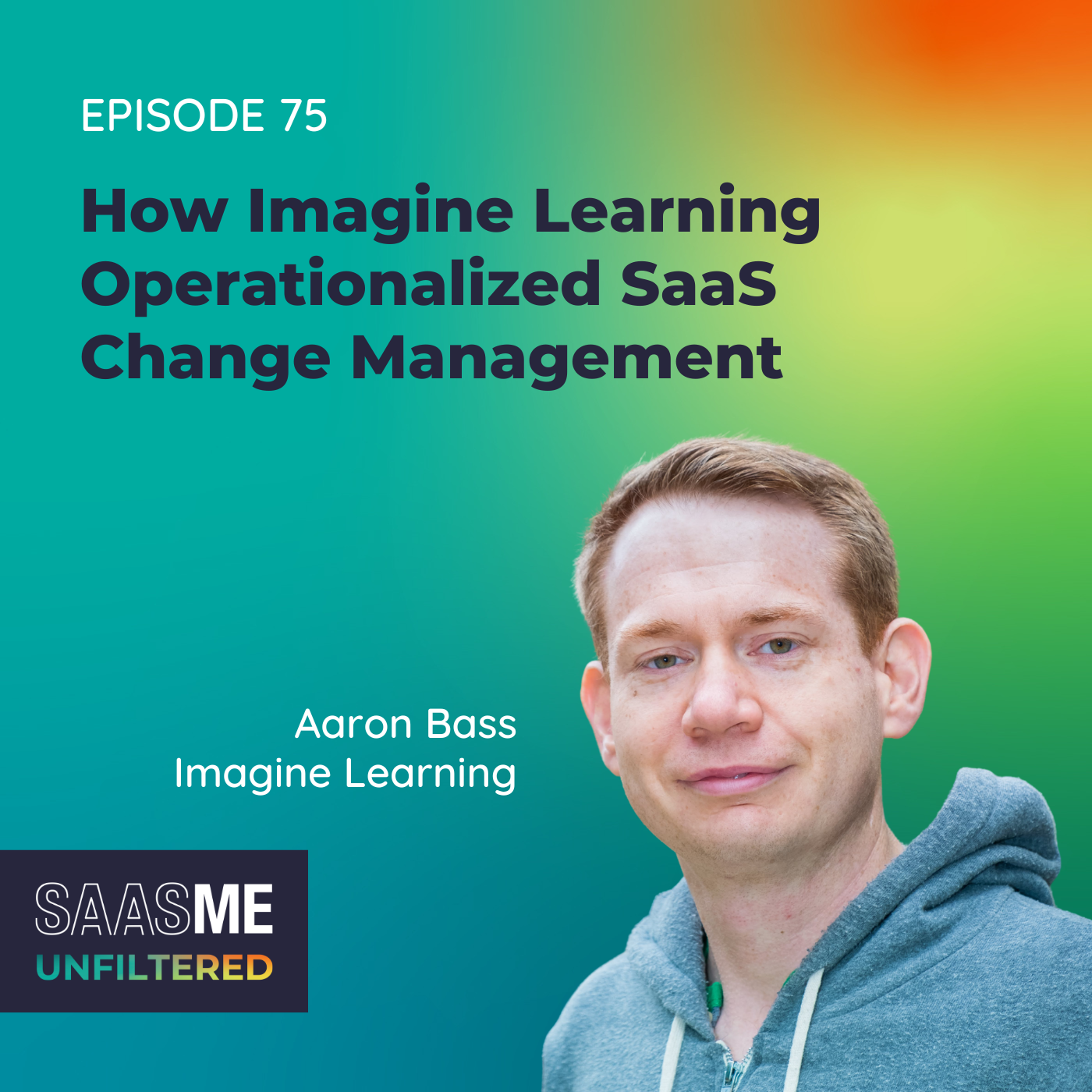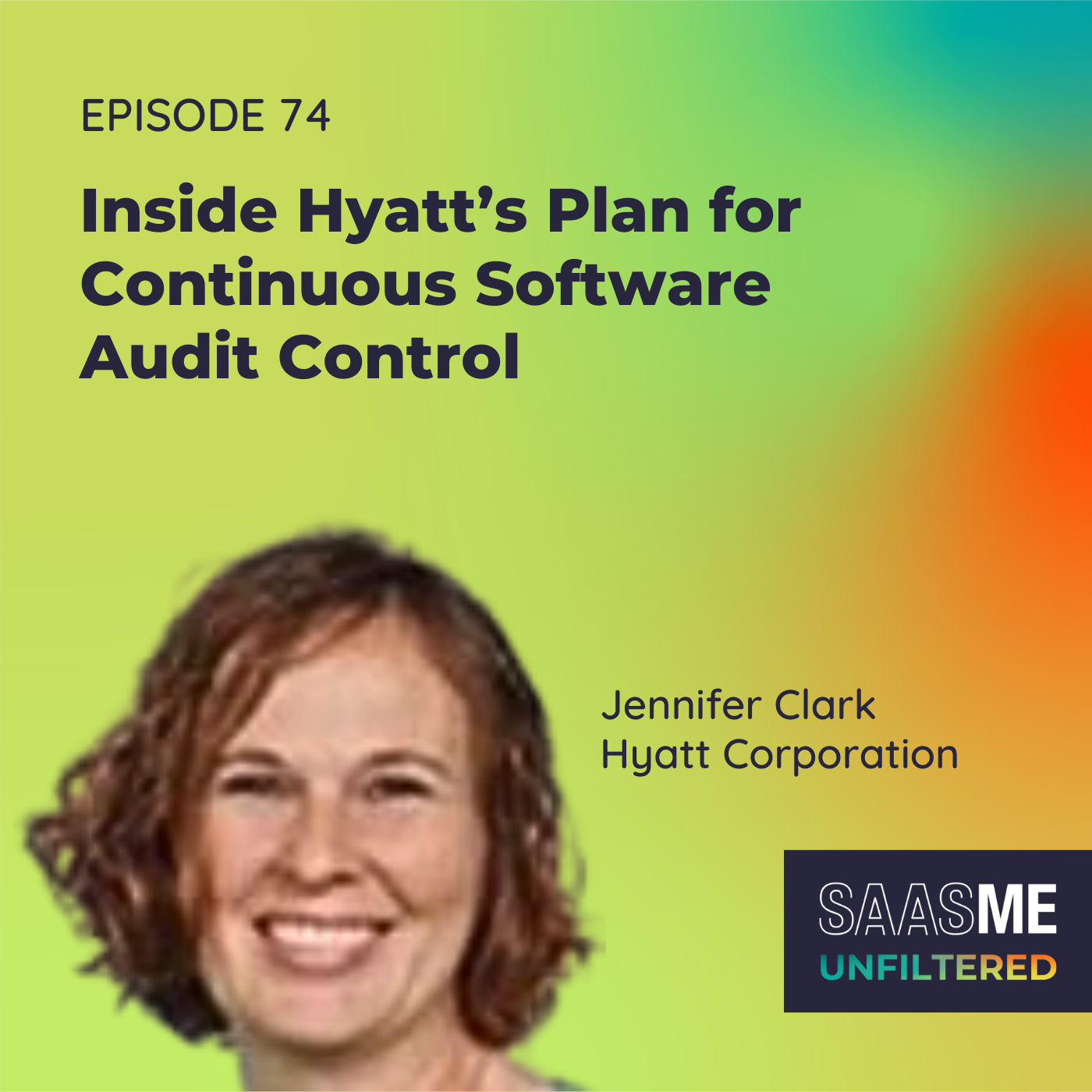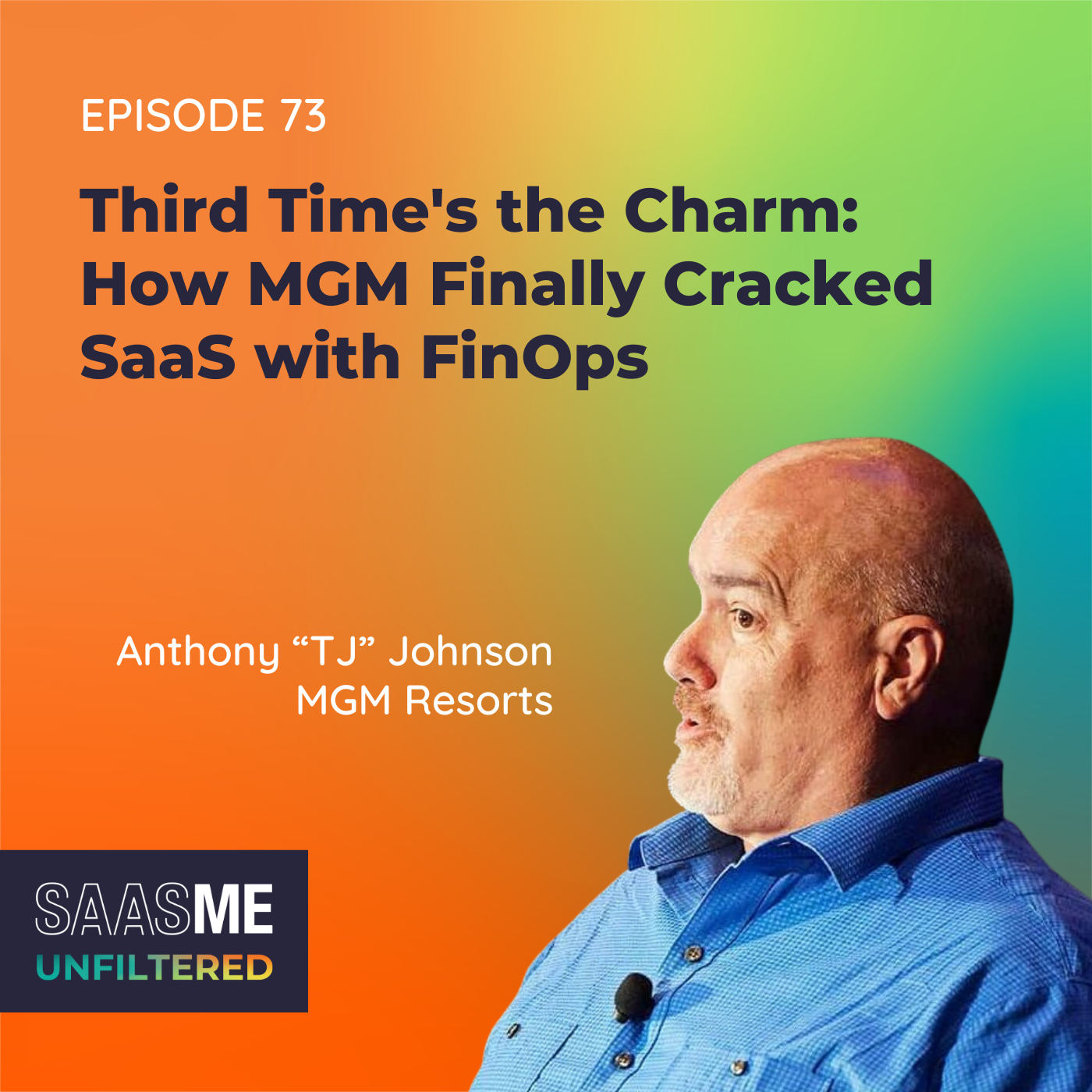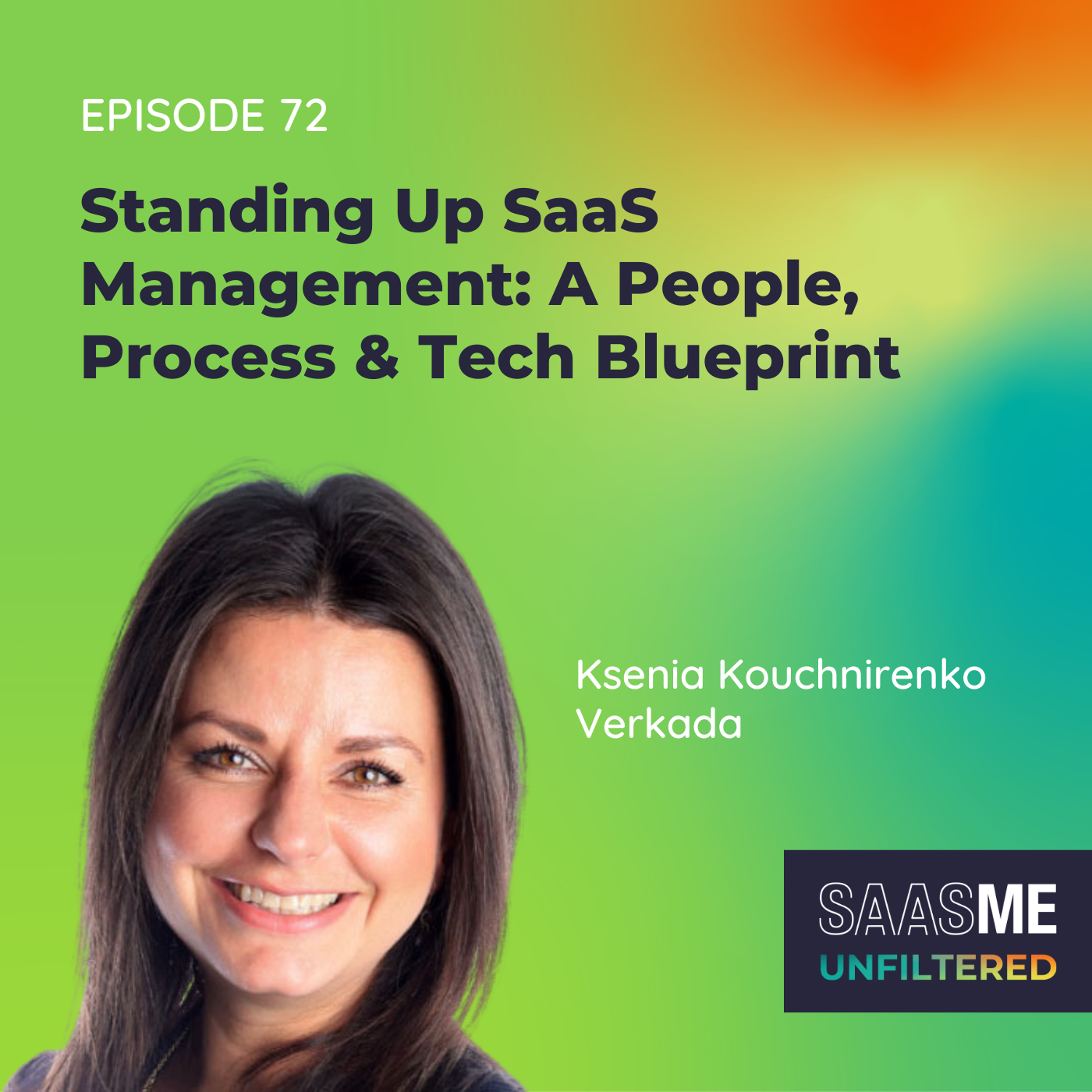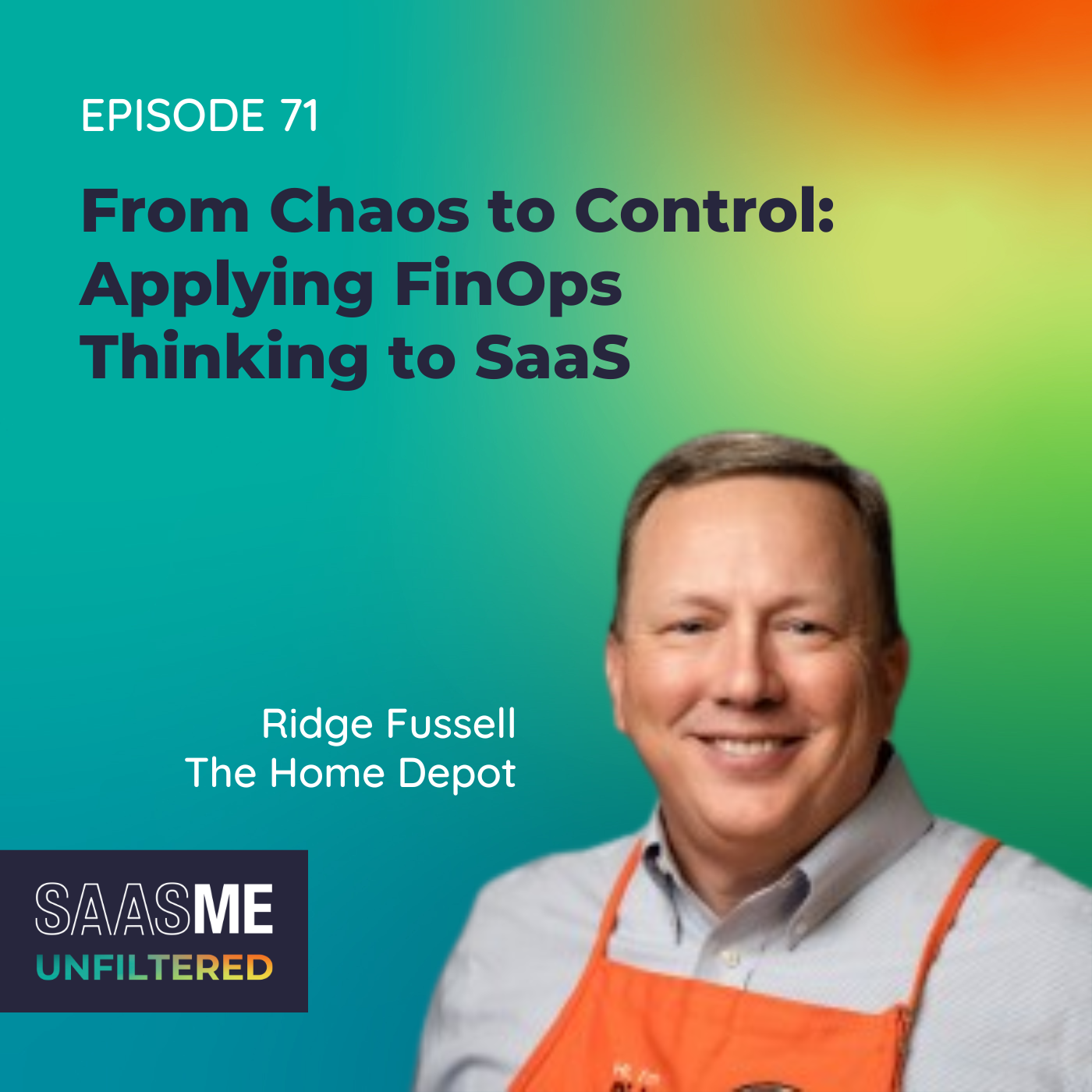Chris Asing: Powering IT SaaS Governance with Partnership, Flexibility & Data
- 0.5
- 1
- 1.25
- 1.5
- 1.75
- 2
Chris: Making sure that we're compliant and we're risk aware and we're actually making decisions with a pretty consistent and systematic method for analysis and due diligence. I think that's key, I think it can't be heavy, and it can't be overly cumbersome. It has to be very clear, straightforward, and efficient.
Cory: Hello and welcome to SaaSMe Unfiltered, the SaaS management podcast, the show with give it to you straight, real life advice from pros knee deep in SaaS every single day, SaaS management superheroes just like you. Welcome back to the SaaSMe Unfiltered podcast. I'm your host Cory Wheeler, chief customer officer here at Zylo and I'm joined by Ashley Hickman, the manager of our customer success team, so welcome everyone. I'm pretty excited about our podcast today. We've got a fantastic guest joining us. So a little bit of a background as we introduce our guest this week, this person is a veteran in the SaaS space. It's one of our customers at Zylo that really gets it when it comes to SaaS management as a function. He came in as the VP of IT at Redis last year, addressing SaaS visibility very quickly to help inform and establish his overall IT strategy, and in less than a year, he's completely transformed SaaS management internally at Redis. He knows how to get the right people in the room to discuss SaaS and has extended the internal SaaS management functionality from technology only to a full service program. So with no further ado, welcome Chris Asing from Redis. It's wonderful to have you joining the podcast today.
Chris: Wow. Thank you, Cory. I have to remember to bring you to my next interview.
Cory: Yes. Well, it's been an awesome partnership thus far. All of that is very genuine and it's truly exciting to be able to get your wisdom, your feedback, and your perspectives on what SaaS management means, how that affects IT, and how it's broader than just IT internally. All right. Well, let's get into it. We'd love to have the listeners understand, Chris, a little bit more, and to kick that off, I'd love to understand, what's your background? You've got a very impressive background. How did you really get into IT, and how has your career transformed over the last 10 years as you've gone into different levels of roles in different organizations and driven IT strategies at all of those?
Chris: I got into IT in the early 2000s. It was a time when there was just a lot of unknown and a lot of excitement around client server and web and client service is something that we don't really talk about these days, but it was a really big part of how things were done 20 plus years ago, and over time it really was just I had the great opportunity and fortunate to be part of teams where I was able to learn and grow from others, and really sort of develop my interests. And over time as we moved from client server over to cloud, it continued to sort of change and evolve, and I found it very exhilarating and inviting to more and more opportunities, and that's essentially how I landed in this space that I'm in now.
Cory: I love it, and you're in the Bay Area, correct?
Chris: I'm in the Bay Area. I happen to be abroad this week, but yes, I live in the Bay Area.
Cory: That's great. I think there's a lot of fun things going on probably in the UK that are emblematic of Redis and where Redis is going. I'd love for you to be able to give a little bit of an overview of Redis. What is Redis and what do you guys do?
Chris: We store stuff in memory. I think the easiest way, the way I would explain this to my mom would be, it's something we store in memory instead of on disc, and so it makes things faster for you. When you're shopping on Amazon, it makes experience faster, better, and easier to operate within. That's kind of how I would simplify the explanation.
Cory: That's good, so I'd love to understand, as we know, we're post- pandemic, the world is opening back up, the Bay Area, the vibrancy of the area is coming back. What's the vibe for you as you start to be back in the office, have team members back together?
Chris: It's a great question. In fact, a lot of our time has been spent just trying to figure that out. What does it mean for the world? And, I can say it's the same everywhere. There's some cultural nuances into how people work, and what they do, and their willingness to come in, and really what they find is personally most effective for them. So truth be told, we've taken a lot of time and effort into understanding what that sentiment is like across our employee population and trying to develop a framework that is sensible, but also reasonable, practical, and empathetic to our entire company. So, what we'll find are flavors of situations where true, many people will be primarily remote and hybrid in nature, but we really want to give people the choice without creating situations where they would be alienated. So, it's an interesting balance and we haven't quite figured it out in whole yet, but I think we're going to learn along the way and we'll iterate where makes sense. One example is like here in the UK people actually do enjoy coming into the office more regularly than say people in the Bay Area. I heard about it, and now I'm actually seeing it and feeling it. I hope to come home without COVID, but I've been on many congested trains while I'm here, so I will say that people really are going into the office here in a much larger scope and scale than the folks in the Bay Area.
Cory: That's good to hear. I think we're feeling a little bit of that as well. When we first started opening up, I think there was a little bit of a tentative nature, but now that we have internal meetings and priorities, we're seeing employees come back into the office in a hybrid way and it's been a lot of fun.
Ashley: So Chris, at Redis, just in terms of giving everyone a lay of the land for what SaaS or really what technology looks like at Redis, is that a little bit of a blend where we're looking at a hybrid, talking about hybrid work environment, hybrid kind of technology environment with on- prem and cloud, or is Redis really cloud forward? What does that mix look like for you?
Chris: Part of it is our timing. We are a cloud first organization. In fact, we don't have anything on premise, so completely cloud first. A lot of that has to do sort of the timing at which we started to grow and scale, and so luckily we never didn't make any significant investments in on- prem or private cloud infrastructure. So, we're 100% cloud first, everything that we do is really focused around that paradigm and all things that sort of complement our workflow and help us mature really have to hook into the landscape or at least have the tenets of being a SaaS.
Ashley: Nice, so being cloud first, which is awesome, amazing, I know a lot of people are trying to get there, so the fact that Redis is already there is great. So, with being in that full SaaS landscape, what is most important for you and ultimately to people you're serving in IT? So, what's important in terms of when we think about metrics that you're tracking, that you care about, that you're kind of discussing and looking at on an ongoing basis?
Chris: One of the very first things that we speak about is with any new, significant SaaS investment is, have we really put a basic level of thought and rigor around the end to end process of whatever it is we're investing in? And, you just can't take that for granted. I think whether it's an HRIS, whether it's a data analytics platform, whether it's a sales and marketing, or go to market type of platform, understanding that end to end flow is critical to try to figure out where your value is and in so that discussion around what job needs to be done by this tool and what are the up and downstream dependencies associated with the effectiveness of this tool become key. So, I would call it an exercise of a business case light- ish sort of set of questions, by no means is a heavy governance sort of discussion, but it really is more of a discussion of, have you thought about it? If you haven't, how does it work today? How do you foresee this working tomorrow? But really important conversations, which in all fairness, different departments have different levels of maturity and some just have not had the time to think of the up and downstream dependencies. So, it really does allow for people to stop, pause, and still operate within the means that they have, but within a framework that is helpful for them to sort of think about and pause before making an investment. So a framework of sorts, but still quite flexible.
Cory: I think that's great. I want to dig into that a little bit here in just a moment. So based on that flexibility, based on understanding and partnering with the business and seeing the upstream and downstream impacts, from an unfiltered perspective, what's your advice on, what does it take to successfully lead an IT organization at a fast growing, tech forward, progressive company like Redis to be able to execute all of those strategies? What do you need to lead IT?
Chris: Oh gosh, I'm learning something new every day, and I think maybe the willingness to continuously be accepting of being wrong, making mistakes, and iterating from your lessons is important. I definitely don't have the answers to things that I think we all don't, so just sort of accepting that and learning along the way is important. And, sometimes the learning is coming from any number of places. Certainly, I'm not a subject matter expert in the functions, but even as from where I sit, the team spends a lot of time tooling and experimenting and they develop subject matter expertise for which I've long since lost. And so, it's always a great opportunity to just listen, learn, and try to understand if you can't connect dots that perhaps others can't to offer an open forum for discourse and learning.
Cory: Listening and learning, and probably two things that every leader needs to be very, very good at, but in IT really being a functional support to the organization, allowing productivity to take place, enabling the business to move at the speed of SaaS, we like to say, is critical, so I love that. Maybe talk to a little bit about IT at Redis. What's that reporting structure look like? Where does IT sit in the organization? What function are you a part of? And, does that play into these key metrics that you're driving to and the overall strategies that you're rolling out?
Chris: It does, so IT reports into the CFO's organization. So, we're part of the G&A function. So, naturally there are things that kind of speak to price per unit, duplicity, understanding our discounts are really important, where our leverage points are. So, some of the metrics when it comes to starting the deal really have to do with, where do we sit amongst our competitors, and truth be told, we would typically rely on friends and a personal network of folks for whom we stay close together and share the data. That's one way of sort of handling it. Cory, you didn't pay me to say this, but I will say that Zylo has actually been a big help in putting some formal structure around that approach through the benchmark product, and it's certainly helpful to understand where you sit amongst your peers, but also just amongst a broader cross section of the industry when it comes to pricing. So, pricing is certainly there, and it's not just influenced by the finance organization. If you were to run the business, you'd be looking at the same sort of thing at a price per unit. Your terms and your conditions for exiting and terms for convenience are also another factor that we look at, but certainly finance has had a pretty important influence in how we operate. Likewise, I think being part of G& A, we're very close to the HR organization, and so the employee experience is also very key for us. So on the one hand, we're a service provider. We're actually processing and prosecuting the work of a procurement organization when it comes to SaaS ingestion and incorporating that into your larger organization. On the other hand, we're a utility provider. We do definitely need to keep services up, on, and performant. And so, just knowing when to sort of press on the service provider or the utility provider approach has been sort of an ongoing exercise for everyone, myself included. Sometimes we have to put our hat on and be a better customer service individual, and other times we have to say," Listen, this is fundamental, and we need to sort of ensure that this is working." So, it's knowing when to sort of put which hat on.
Cory: Sure, we're pretty passionate about SaaS management and the explosion of SaaS, the distributed management of SaaS throughout every organization that's already taken place really has brought to light exactly what you just outlined, software in an organization is critical. It's typically in a company like Redis or a fast growing tech company, the number one expense line item under headcount, and when you think about the management of it, with everybody in the company, either a user, a department, or a group, an IT organization purchasing and leveraging SaaS, the distributed nature has really risen the strategies to be both IT and finance driven. And, you being in an IT organization that has a broader influence from finance, you're at that perfect intersection of providing employee experience, providing tools that allow your employees to get things done, a wonderful employee experience around that, but also the responsibility for security and the responsibility for a fiscally, I guess responsible approach to how you're leveraging SaaS, and I've always admired how you implemented and brought that together from the jump when you came over to Redis and built your IT organization. So, very cool thinking about how SaaS is exploding and how to drive that value, it's multidisciplinary, and you've really woven that together really well at Redis, so nice work.
Ashley: Really ties nicely in with governance. So, prior to coming on board at Zylo, I was doing IT consulting for a number of years, and at the end of the day, you're providing a service, a shared service. However, like you mentioned, sometimes you are the prosecutor. You have to enforce whatever rules, regulations, compliance needs that are being dictated from the business, maybe just dictated from anything that you have to adhere to within the business. So within that, with governance, we see a big range with the customers that we work with, customers I previously worked with in my past life, there's a big range of what that can mean for every organization. And, we love to preach freedom within a framework, so you have the opportunity to join us at our first SaaSMe conference, SaaSMe'21. You were on a panel with Talkdesk and Slack and really shared your ideas, kind of looking at what is a distributed versus a centralized model for management of SaaS, so essentially governance. That's something that's a little bit stricter, something that's a little bit looser, what that can look like, and that was a great conversation. So, I would love to hear... Now we have you here joining us today to share with everyone really the best approach for Redis internally when it looks at governance at centralization, more distributed model, it sounds to me like you have a few people in play, but would love to have you speak a little bit about that.
Chris: Thank you, actually that's very kind of you. I will say the model in the framework has to be able to change. I think that's key. You have to be able to sort of understand what the needs and the maturity of your business is and be able to iterate it when appropriate. The business knows their area best. They'll know which tools do the right job for them, and I would hope and trust that they look to our organization, IT, to do the same thing for the IT and business services function. They have the workplace technology functions, but the framework itself, it started off for us at Redis, it was really just a funnel for handling intake. So, we'd start to ask some pretty common questions. Is this something that is SAML enabled or is there a SAML tax? Is this something that can be SCIM provision? Because that helps with productivity and automation, providing sort of this birthright experience where if you belong to a function, you're provided with certain assets and properties, and these are all sorts of questions, which really sometimes the business doesn't even think of, or they may have actually experienced at their prior job, and would like to appreciate that same value in this new company. And so, we want to offer that. We want to be able to sort of grow with this company and offer a faster, better, cheaper, and in the ways that we can, and those are those few things. SCIM provisioning is a key question that we often ask, and it often sounds like a bit of alphabet soup for the business and they go,"I've never heard of SCIM provisioning," often times-
Ashley: They're like,"Skim milk? What is that?"
Chris: Yeah. What is this? And so we talk about like," Oh my gosh, I think this is what I had at X, Y, Z," or," Oh my gosh, I would love that," and we're like,"You know what, we'd love it too," to be completely fair. We don't want to create tickets to provision Salesforce. We know every salesperson will need it. So things like that... I think this is sort of the start of that framework and saying," You know what, there will always be exceptions to this and accepting these exceptions as they are." And, then just sort of making sure that we're compliant and we're risk aware, and we're actually making decisions with a pretty consistent and systematic method for analysis and due diligence. I think that's key and it can't be heavy and it can't be overly cumbersome. It has to be very clear, straightforward, and efficient. So in the same way, our own governance process has to be performant, not just the tools and the processes itself, but it's the process and the framework for SaaS really. I hope that was helpful.
Ashley: Oh no, that was super helpful. So, I'm curious about in terms of... Because you mentioned getting feedback from the business, and also it really is a two- way street. Something that I see a lot of people struggle with is just getting the business to listen, that can be a big challenge, and maybe there is a very highly collaborative process that Redis has in place. It sounds like it, but around how you've gotten to the place you're at with Redis, where it is a collaborative, it is a two- way street, there is a back and forth conversation. Maybe it's just having something posted on the internet and everyone does follow that, or if it's just a continual iterative process, as you mentioned.
Chris: I wish I could take all the credit for it, but I can't. We really partner with finance and legal and we recognize that there are always these three parties. We've definitely partnered with security, the larger product security team as well, but this is really important, partnering with your, your financial and your legal counterparts in the flow of SaaS management is really key. You're buying a lot of things, you're using a lot of things, and typically you're stuck in it for a year or more, so partnership is key. I think making sure that, again, asking the business, what are you using this tool for? What job needs to be done with this tool? It's the same sort of thinking around, well, what do I need and who needs to be part of that discussion? Well, we do need it to be price competitive. We also need it to be secure and compliant, but we have to sort of check a lot of boxes in this flow, partnering with the controller and finance was key for us in the beginning because they also shared a similar interest and it could easily buy into the discussion, so too with legal, and why would they want to start a whole nother process when they could just join mine? And so, they would three questions, I would have five, and would have two, and we're done, it's a very quick form, and I think by doing that, we made it less frustrating for a business user to and things because it was consistent and systematic. Now, is it perfect? No, it's not perfect. I think we're always striving for making it better, making it more relevant, and making it faster, but I will say I'm pretty happy with where we've come, and I think we've come a ways with that process since I've joined both internally and with our external partners.
Cory: I think the way that you are interfacing with the business is that progressive new school of thought. Partnering with the business to get them the right tooling at the right times when they need it is how you drive productivity, it's how you drive progress in your organization, and it's how work gets done. It's the new world. SaaS is the new workplace. Along with that, you have the difficulty of then balancing risk and you mentioned security, and typically IT is on the hook for those. If there's a data breach, if there are tools that are unsecured, if they haven't gone through legal, things like that, those are always criticalities that sometimes keep leaders in IT up at night. How do you balance that, and have you gone so far as to roll out policies or are you very anti- policy, more collaborative and process driven?
Chris: I'll say this, when it's me buying something, I don't like policies and procedures, but when I'm responsible for the health and governance of whether we've done in due diligence, I love policy and procedure. Not that I like to hide behind it, but it does give me something to stay consistent with and to be fair about and not forget. So, we do need a policy, we do need a stance on it, we have to pick side first off, and then we need a procedure to do the work, and the procedure is important because like anything, I think inconsistency is the cause of a lot of errors. We have maniacal focus on consistency. Then, we can start focusing on automation and efficiency. So, the consistency is really key for us. Let alone, the auditors love procedures and documentation, but it really truly is about scaling a company. How do you do things faster, better, cheaper? Well, first you write it down and two, you do it consistently, and then you make it better and better over time, you iterate it and you engineer out the waste and the errors. So, security oftentimes gets a black eye, but I will say they're doing the right thing for the right reasons, and they're there to protect the company. So, we just need to do it in a way that's performant. I love policy and procedure when it comes to us serving the business.
Cory: Sure, I'd love to talk a little bit about... One of the other things that we've seen, the rise in SaaS create. The rise in SaaS means that where a company might have been using 50 to a 100 tools 10 years ago, today they're using hundreds, and what that leads to is a massive increase in administration, in the ability to execute on the life cycle of every single SaaS tool inside your business, from looking at the market, looking at competitive solutions, to vetting and the intake process that you mentioned, to then really being able to execute renewals on all of those, data- driven, intelligent renewals around all of that. So, when you start to multiply that out in the hundreds of tools, we see a massive administration there and you were very early in addressing that and transparently that was via partnership with Zylo, where you're leveraging the Zylo team and expertise there to help drive those negotiations and help drive the administration of all of the backend data and details around your SaaS applications, the onboarding, and the off onboarding, and the intake, and really maintaining that centrally. So, as you think about how you've successfully launched both an in- sourced and an outsourced program to address that administration, what's key to driving that success and how do you think about SaaS management as being more solution oriented than just a technology to understand what you've got?
Chris: There's kind of two pieces, which sort of helped us. One is you have to have the data and then it's trying to make intelligent, or at least hopefully sensible conclusions about that data, and making those connections, and so starting with that is key. And, I think prior to having a status platform to understand what it is we are consuming, or I should say this, what it is we bought, and then what it is we're using are two very different things. And, how do what that is or how do you know that is in an efficient way? So, this was one of the biggest struggles that I think myself and my peers, we used to deal with all the time, whether you're using Zylo or any other sort of SaaS management platform. The way you do that is you'd actually go and sort of work with finance, and do an export, and understand what the company's buying and hopefully have enough insight into that data to draw some conclusions. What you'll typically get out of these exports are some combinations of vendors, products, and SKUs, and you have to try and make sense of what it is you bought and what it is you're using, and what it is you bought you may not be able to make all the connections with, or you don't understand it. Is this duplicative, is it not? Are we using it, are we not? Is it old data? So, just having that as your problem statement, how do you go and fix that? Well, you come through exports of Excel files. What I would sort of challenge that with is that everyone will need to do that for the rest of time. As long as we have companies, we will have to manage what it is we buy, whether that's a piece of hardware, a piece of software or an entitlement, whatever that is. And so, I think in the case of Zylo, at least for us, it's been having that data, drawing on conclusions and categorizations and insights that the platform has provided with us, and then on our own terms, and sometimes I wish it was faster, on our own terms, figuring out what's important for us. Are we trying to just get the data correct? Because that was the first step. Do we have all the contracts in? Are they relevant still? Are they still in the period of term? And then we can look at, are they duplicative, and are we looking at everything or are you just looking at things above a certain dollar threshold? And so just trying to figure out, what are your business objectives, and use that data to assist you and really commit to using a system, not many systems, and by us doing that, I think we've been able to sort of really understand our portfolio. We know what we have right now. We know where we're duplicative.
Cory: Yep.
Chris: We know what's expiring, we know our opportunities, and it actually gives us a lot of insight. So, as we shift from more operational growth to strategic foresight, I think we're able to sort of use that data in different ways. The first, I'll say couple of quarters, were really spent on making sure contracts are there. Here on out, it's a very different discussion as to what we're doing today. We're not really messing so much with, are there contracts in there associated with these entitlements? It's more of, should we move things from expense to PO? Should we actually eliminate this product? Should we combine these? So, it's a very different... It's shifting from less operational, a little bit more strategic and that's going to continue happening. It's just part of our growth stage. So I think just starting off, and to answer that, it's really about the data. It's using that data then to sort of make some intelligent decisions and then continuously sort of iterating off of that and then pulling the business in. I think what's meaningful to me, I know it's also meaningful to other departments, so helping them understand you're a sales organization, you have a lot of tools, are you sure you want to buy this other one? Isn't this one like the other one, or am I missing something? Do I have something to learn? And, it actually brings people together a lot of times. You might have a situation where an organization in one region has the same problem as that same organization in another region, and you just have natural duplication unknowingly. The left hand didn't what the right hand was doing, and it actually brings some people together into like," Oh, I didn't realize this is a problem, and you're actually solving it. So, I don't need to do mine. Thanks for paying for it because I didn't have it in my budget anyway. I would've had to ask for it." So, you have a lot of this sort of discussion that just organically comes up as a result.
Cory: I think that's an awesome concept, and we work with a lot of customers up market that have teams dedicated to enterprise architecture, and so many of the concepts that you walk through, the fit in the business, the business capabilities, mapping the apps to where those business capabilities are, are those enterprise architecture concepts. And as you guys are growing, you don't have teams dedicated to that today. So from an enterprise architecture, what's our application stack, how do we map those capabilities? How do we map them to our own product, our go to market? How do you take that on with everything else, operationalizing and opening up offices globally and managing IT across the company? Enterprise architecture just kind of has to be core to your DNA. Maybe talk a little bit about how you think that fits into your overall IT approach.
Chris: It's a fantastic question you ask. In fact, I'll say I wish I had a great answer for it, but the honest truth is this, there are tools that we use within IT, the business application stack, that may be more mature yet duplicative than in other functions. So, product A offers a wonderful workflow tool for all of the IT properties, but when I move over to the sales and marketing stack, it's another workflow product that actually solves the same problem, but it integrates with the right tools. And so while it may be duplicative, it's actually serving that function significantly better than my product would be serving their function because the products themselves haven't matured. Everyone's sort of expanding, and sort of saying," Look, I work with say product A, B and C, but this one works with X, Y, and Z." We sometimes find ourselves in a situation where we are deliberately taking on two tools that do a very similar thing, but are compatible with their domain of tools. It's a very interesting thing because I think at some point many of these workflow and automation tools will converge or they'll start to cannibalize one another and you see that a lot. You see that in security products and you see it in backup products and a number of different go to market tools. So, I think what we're finding is this, we see this happening, we see a lot of duplication of base foundational functionality around workflow and automation. The reality is sometimes the compatibility just isn't there for the job that needs to be done. It's something that I think we see in the SaaS world because SaaS has been around for some time, but some of these tools to really enable and scale SaaS are really just coming out to market now.
Cory: Yep.
Chris: So what's funny, when I think about some of these things, it's a workflow automation. Outside of some of these other tools, I've actually started using some of the tools within Zylo to discover some things and do some things, and one example is the tool that we're speaking on right now, Zoom.
Cory: Right.
Ashley: Yeah.
Chris: Zoom has been a game changer for everyone. We all went into the pandemic and suddenly everyone... They use Zoom the same way they use the word Google.
Cory: That's right.
Ashley: Mm- hmm.
Chris: Well, the reality is not everyone needs a certain type of license, and I've been able to sort of really capitalize on some of the workflow and automation tools to discover, and then take action where there's under utilization. So, it is all just a capacity management exercise, but it's been extremely helpful to build automation versus manual sort of work.
Cory: I love that. This has been a really fun conversation. I think you've got a broad purview internally at Redis. You're taking a lot of different internal competencies and you're doing so bringing teams together. In the first year plus... You're now there a year plus, I'm sure it's gone very, very quickly, you've driven a lot of change internally at Redis and it's pretty impressive. So, we're going to close out with a fun activity. We're going to do a little word association. I'm going to throw out and Ashley is going to throw out a couple terms, provide a one word response or a sentence or whatever you want to do. Your quick thoughts on these concepts, short, sweet, to the point. I would love your perspective, okay?
Chris: Great.
Cory: All- righty. Here we go. First one, SaaS management.
Chris: Cloudy.
Cory: Perfect.
Ashley: Shadow IT.
Chris: Here to stay and start to love it.
Cory: Yes.
Ashley: There we go.
Cory: Yes. Here's a good one for you, Chris, negotiation.
Chris: Partnership.
Ashley: Nice.
Cory: I love it. A sidebar there, when I first met Chris and we talked about partnering together, he said," You better understand, Cory, that I love negotiation, and we're going to be partnering with you to drive negotiations as well, so it's going to be a process and I want you to be ready for it, and we're going to get to some place really, really great, but there's going to be some negotiation," and it was fantastic. I think it's core to how you drive optimization internally at Redis, and it's been a fun partnership. So I'll get out of the way, Ashley, back to you.
Ashley: Vacation.
Chris: Vacation, all right, someplace where I'm wearing shorts, slippers, and maybe a shirt.
Ashley: Shorts and slippers, I like that. No sandals, slippers.
Cory: Very good. Beverage.
Chris: All right, so it's going to be water.
Cory: That's the right answer, Chris. That's actually the right answer.
Ashley: Podcast, books, media. What are you listening, reading to lately, any recs?
Chris: When we went into the pandemic, my sisters formed a book club, so I'm outnumbered in this book club. So yes, I will say I'm listening to some audio books, they're not my favorite, but podcasts, let me go there. Conan O'Brien Needs a Friend, highly recommended, and a great way to sort of break the noise so to speak.
Cory: I love it. Well, Chris, on behalf of Ashley and myself and the whole Zylo crew, we were so excited to have you on today to share your insights. The work you've done at Redis has been impressive, the partnership that we've had internally has been transformative for your organization and as you really push the boundaries of SaaS management in a very fast growing organization, so thank you so much for joining us today. It's been a blast and I look forward to the next conversation.
Chris: Thank you, Cory. Thank you very much, Ashley.
Cory: Did you enjoy the episode? Pass it along to your friends. Subscribe to get notifications for the latest episode. Share your favorite takeaways and join the conversation on social media using# SaaSMeUnfiltered.
DESCRIPTION
Listen and learn. Redis VP of IT Chris Asing lives by this mantra in his approach to SaaS governance. But it’s not all just policies and procedures. In this episode, Chris gives an inside look at his progressive approach and the power partnership, flexibility, and data have in SaaS transformation.
Episode highlights:
- [2:02] How Chris got into IT, and background on Redis
- [3:43] Thoughts on offices opening up post-pandemic
- [5:27] What a "cloud forward" mentality looks like at Redis, and metrics it causes them to track
- [8:00] What does Chris need to lead IT at Redis?
- [9:23] IT structure at Redis, and where it sits in the organizational hierarchy
- [12:56] Governance and centralization efforts at Redis
- [16:24] Feedback from businesses is a two-way street
- [18:24] Balancing threats to risk and security as a core focus of IT
- [20:27] The rise in SaaS and its implications on the number of tools we use
- [25:51] Enterprise architecture as core to a company's DNA
Today's Host

Ben Pippenger
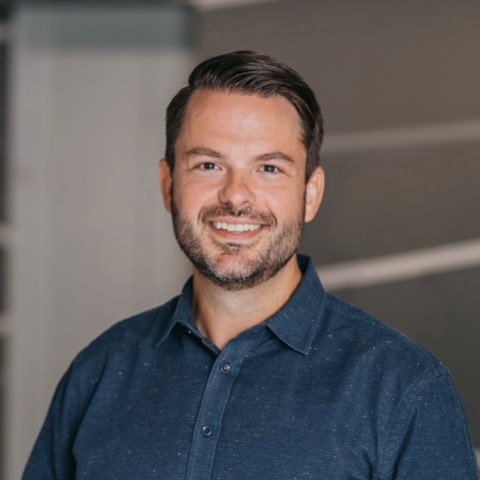
Cory Wheeler

Meredith Albertson
Today's Guests


